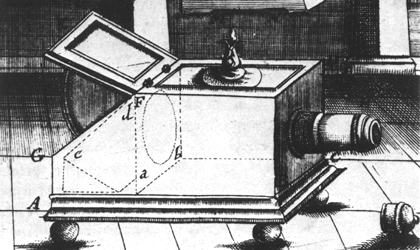John
Vink
Cambodia-based
photojournalist
John Vink is a native of Belgium. He
has won the Eugene Smith Award for his work on Water in Sahel.
A former member of Agence Vu,
he joined Magnum
Photos in 1993.
Wayne: You have said that your father was a very good amateur
photographer. What memories do you have of his photography?
John:
Did I say very good amateur photographer or good amateur photographer?
Anyhow, he knew very well about all the technicalities, exposure,
filters, depth of field, lenses… He had a Leica,
I think a 3F or a 3G. (I bought one later on and took pictures with it
of the psychiatric ward I managed to get sent to to avoid doing
military service.) But the things my father photographed were the
family, cherry blossoms, mountain ranges and the occasional chamois,
small as a dot against a big mountain slope when we spent our summer
and winter holidays in Switzerland.
Wayne:
You have also attributed your photographic interests in part to the
copies of Life magazine that were kept around the house. What was it
about the magazines that captivated you? What other books and magazines
did your parents keep around the house?
John:
The Life issues were hidden in the cellar (there was no attic in our
house). There was a small storage room opposite the garage with piles
of magazines. I spent hours in there. The first pile of magazines I
came across was National Geographic. Old
issues
from
back
in
the '30s as well. Must
have given me a hint about going to other places.
Behind
that
there
was
a
pile of Life magazine. This was in the late '50s and
early '60s, and my parents who had gone through World War II did not
want their children to be confronted with the war. [David
Douglas]
Duncan’s
pictures of the war in Korea (muddy soldiers sloshing through rice
fields, shell shocked troopers in the cold…) probably motivated my
parents to hide those issues. It was at the height of the Cold War, and
I had bad dreams of Russian planes dropping their atomic bombs on my
head, yet I took the Life issues with Duncan’s pictures up to my room
and looked at them at night with a
torchlight. I also had copies of Popular Science explaining how
to build an atomic shelter…
Even
better
tucked
away
was
a pile of photography magazines with articles
about how to compose a picture, how to take pictures of fireworks and
the like. All topics I wasn’t interested in at all. But surges of
hormones kept me flipping through these photography
magazines anyway, because there was also a chapter on lighting nude
models. I learned a lot about how not to light a subject and about
human (well mostly female) anatomy this way, although the absence of
pubic hair, and in fact the absence of everything (the pictures were
strategically retouched) kept certain questions alive…
Wayne:
What kind of influence did Duncan have on you? Which other
photographers influenced you when you were a young, up and coming
photographer?
John: I can’t say if Duncan
or any other photographer had any direct influence on me. I think it is
more a combination of feelings, encounters with certain images at a
certain moment which molded me over time. I mean, growing up is a slow
process and needs a lot of input from many different origins. It is
never like a thunderbolt hitting me and making me change direction. The
Duncan pictures and the
atmosphere surrounding it at the time, the digestion of all this, maybe
partly explain why years later I never really photographed the paroxysm
of conflict. I am not a war photographer. I am a post-war photographer
and sometimes a pre-war photographer.
I
also
think it is a bit reducing to mention only photographers as an
influence just because you’re a photographer yourself. My artistic
stimulations are varied and relate to music (Arno, Lou Reed, Bob Dylan, Nusrat Fateh
Ali Khan, Swirling Dervishes, J.S. Bach…), painting (Permeke, Saverys, Alechinsky,
Ensor…), and yes,
photography (Larry Clark, [Diane] Arbus,
[Robert]
Frank,
Sergio Larrain,
Graciela
Iturbide …), literature (I was devouring Jack
London as a kid) and certainly comic books with the one and only Hergé, creator of Tintin (maybe this will explain why
I try to have everything in focus)…
There
is
one
photographer,
though,
who at least triggered my desire to become
a photographer. I was 15 or so and probably quite stupid and stubborn
when the “Ye-Ye” period hit France and Belgium. There was a very
popular radio program (no TV at home!) called “Salut Les Copains”,
featuring
a
new
trend
of singers: Johnny Halliday,
Sylvie Vartan,
Françoise Hardy. It was in fact the first successful attempt to
drag
the baby-boomers into consumerism. The success was such that a
magazine, appropriately called “Salut
Les Copains," came on the
market, with pictures of all these stars and starlets of the new
showbiz in France. Most of them were done by a Jean-Marie Perier.
In each issue of the magazine there was an article about “The job you
dream of.” The first issue told you exactly what you should do if you
wanted to become an air hostess. The second issue explained what it
takes to become a photographer. And there was Jean-Marie Periertele-lenses telling the world and credulous me
(happy possessor of a Voïgtlander
Vito CD) in particular how much fun it was to be a photographer and to
approach all those stars. My decision was taken: I wanted to quit
college and become a photographer sitting amid all his cameras.
Wayne: How did you decide to study at
La Cambre? What was you
parents’ reaction to your interest in the visual arts?
John:
My parents weren’t too happy with my decision to quit college and put
heavy pressure (fair enough) on me to finish what I started. It took a
while longer than expected, of course, because after my decision, my
motivation to do that was gone, my mind being focused on becoming a
photographer. But I managed to get through the ordeal. I guess that by
then my parents expected me to have dropped the foolish idea. It turns
out I didn’t, so they thought I might as well get the best weapons to
achieve my goal, and I went to the fine arts university of La Cambre. The concept of La Cambre was in fact copied from the Bauhaus:
a
collection
of
several
interacting visual arts disciplines, ranging
from graphic arts to etching and from sculpture to animated film. Now
this was September 1968! Not the right time if you wanted to study at a
high school or a university, but fantastic if you wanted to fool around
and spend time finding out what you wanted the world to look like. The
guru we had to deal with in the photography department obviously lacked
substance and stature, and basically we were left on our own. I picked
up a lot in other departments, so finally it was a good experience,
even though in the field of photography as a profession I was left
quite helpless. But we had been following a very good class on the
history of photography, and that certainly was where I became aware of
the different worlds photography can take you to and that finally
telling people’s lives, like Dorothea Lange or Gene Smith did, was
something I could relate to.
Wayne: How did you end up initially
photographing theater?
John: In fact, right after La cambre
I started my “career” as a fine arts photographer with these pictures,
got them published in the [Swiss] Camera, and they were exhibited left
and right in an emerging fine art market, and namely at the Jürgen Wilde Galerie in Köln (Germany).
They were the discoverers of Bernd
and
Hilla Becher a little later.
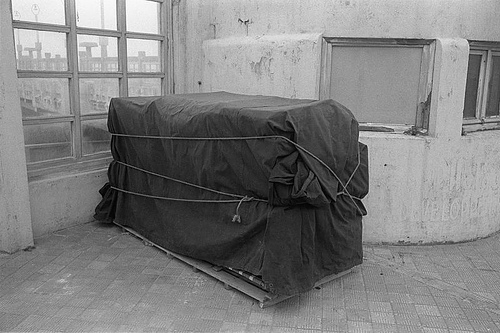
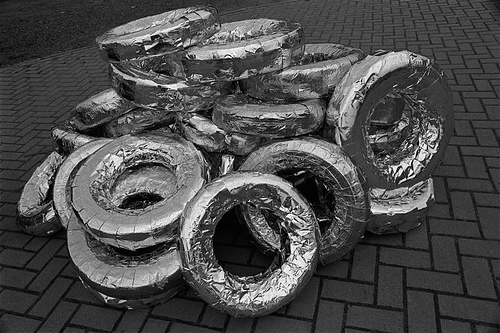
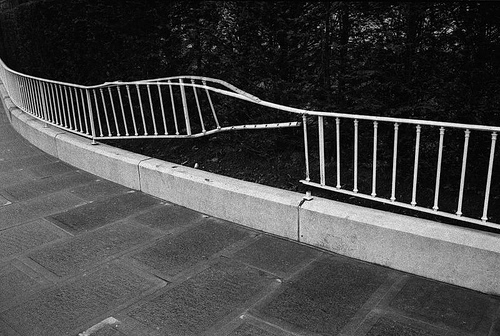
But
after
a couple of years I thought I would be running into a dead end soon,
and the desire of being a photojournalist, which popped up at La Cambre, came back. In those years I
also took these photographs, comforting me somehow in that direction:
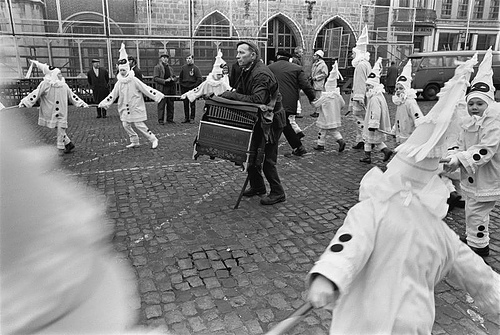
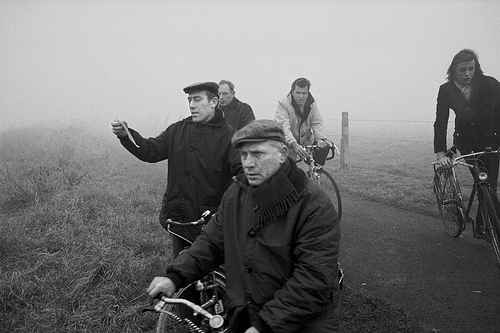

But
there
were
no
decent
magazines in Belgium at the time. Only dailies who
would pay ridiculous copyrights (if they even knew what that was). And
I really didn’t know how to move ahead. My former wife, who I met at La
Cambre, was a stage
designer
and that is how I got in contact with the more progressive theaters in
Brussels. I started taking pictures for them and soon ended up doing
things a bit differently than what they expected. I was more taking
pictures of the process of creation than of the play as such, and very
often I was on stage with the actors during the repetitions, showing a
totally different perspective than what the spectator would ever see.
The great thing with theater photography is that you can anticipate the
events: you know that when X says “blablabla,"
that
Y
will
be
staying there, looking in that direction. It really has
helped me tremendously in the all-important issue of finding the right
position, the right distance.
Wayne:
How, in particular then, has music influenced your aesthetic? How has
it influenced your methodology? In the way it affects the way you
structure your coverage and themes?
John:
Music has more of a ‘getting into the mood’ function than a direct
influence on the aesthetics. So it is not directly related to
photography, but it helps me apprehend situations before starting to
photograph or to digest the situations afterwards. Reed to pep me up
and for when I know I’ll have to rock; Waits or “Vier Letzte
Lieder” from Strauss by Jessye
Norman for when I want to isolate on a plane; Swirling Dervishes to
cool down but stay concentrated; Nusrat
Fateh Ali
Khan (the real Sufi stuff, not the “world music” thing) for when I have
to go beyond the real world. I never listen to music while
photographing, of course. I mean, you have to photograph with your ears
as well, so there is no time to listen to music.
Wayne: When you were at Liberation,
you learned to work in a method the photojournalists there called “décalé.” How much
does that method still influence your work?
John: I worked a lot for Libération, but never was “at” Libération, even if Vu
agency [Agence Vu] was a daughter
company of Libération
at its beginning and had its offices in the same building for quite a
while. The initiator of the whole idea was Christian Caujolle, former picture editor at Libération whom I had worked
for a couple of years before he put together Vu agency. Christian,
during his years as a picture editor at Libération
indeed managed to use photojournalism in a way which had rarely been
seen before. It was a matter of looking beyond, to search the edges, to
visually scratch beneath the surface of what’s available at a
journalistic event and come back with images which were relevant and
yet different from what one would expect. It was a matter of creating a
surprise effect, catch the attention and bring the reader to apprehend
the accompanying text with a critical mind. Libération
became known for its unconventional use of photography and this
certainly contributed to the success of the newspaper at the time.
The
same
idea
was
used
by the picture editors at Libération
who were using stock
photographs. Sometimes the results were quite far fetched, or plain
funny. I remember that this picture:

or this picture
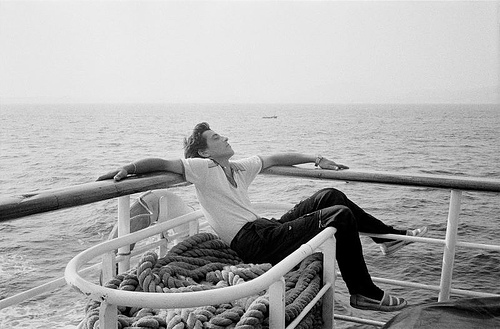
(I
don’t
remember exactly which one but I’m sure it’s one of the two): was used
for an article about a survey which found out that the sperm count with
the population in the West was declining…
The
danger
with
“décalé”
is that you could end up using or producing pictures where aesthetic
virtuosity becomes more important than the content. It is something I
always was very cautious not to do, though, and the “décalé” taught me
better where I would and should put my limits in this regard.
But
anyhow,
Christian
Caujolle
thought that the concept he successfully used at Libération
could be expanded and applied to other news media and also to the juicy
market of annual reports or advertisement. So he gathered a bunch of
photographers (Michel Vanden Eeckhoudt, Gérard Uféras,
Pascal Dolémieux,
and
later
Hugues de Wurstemberger…)
around him he had worked with when he was picture editor and founded Vu
agency. It worked fine for quite some time. The line between journalism
and advertisement photography became blurred a bit, but it never really
bothered me because there was enough space for both options within the
agency. For me it was just a matter of drawing the line again as to how
far I would go into the direction of non-journalistic photography, and
that was pretty not far away.
Vu
was very trendy for six or seven years. Then Libération
began to have some difficulties and there were rumors that it would
close its daughter company. So I left Vu end of ‘92 before 15 or so
photographers would be looking for a place to harbour
them and subsequently applied in ‘93 for Magnum. As it turned out I got
into Magnum and Vu is still around. Meanwhile, I had completed the
Water in Sahel and the
Refugees stories.
Wayne: You have talked about your
“need” to leave Belgium. Why was that important for your sense of
mission? For your development as a
photographer?
John:
Belgium is a really interesting place with a rotten climate. It is the
friction line for two strong cultures and has been a battlefield for
every European army (and even a few non-European armies) for many
centuries… It counts an abnormal proportion of creative people doing
things no one else in the world could come up with and counts an even
more important proportion of narrow minded bigots. The food is
fantastic, the beer is the best in the world, quality of life is
probably unequalled, but sometimes I feel this is a cover-up for a lot
of hypocrisy. Belgium is the champion of compromise (maybe that’s why
it is the siege of the European institutions). Belgium is Catholic.
Belgium has a coastline of 60 km. Belgium (the Flemish part at least)
is one village. Belgium is crowded. Belgium is satisfied. Belgium is small. You want to get out of there.
Maybe
if
I
had
stayed
I could have found an equivalent to each and every
story I did in Africa or Asia and dig into Belgium as I’m digging into
Cambodia now. But it turned out different, the itch to to
go out there and see for myself, check things out with a mind as free
and uncluttered as possible was too strong it seems. Things look
crispier, it feels like you grasp what’s going on faster, that you analyze
a situation better when your memory has no references. I think
photojournalism is about knowledge but much more about intuition and
open mindedness.
I
ended
up spending only a couple of months at home each year for several
years. Shall we blame it on National Geographic or on the school’s
atlas with all these incredible names in Siberia or in South America? I
don’t really know. Once you’ve been bitten by the travel bug it’s hard
to settle down. Being away also makes it tough to maintain fulfilling
relationships, so when you come back for some time you find out that
they are not satisfying—and leave again. You get dragged into a spiral.
I did try to settle down a little more after becoming a nominee at
Magnum and even started a documentary photography magazine called
"Themes." I managed to publish five issues, ran out of money and
started travelling again,
working on the mountain people story.
Wayne:
Why has it been so important for you to cover the “powerless and poor?”
Why refugees in particular? From where does that sense of justice and
injustice stem in you?
John: Why do you climb a mountain? Because it’s there.
I must say I never understood why people talk about well-known people.
They have a voice already. So why add more noise? Too much information
becomes noise. I never understood (or rather, wanted to accept) the
fact that all the media focus on the same topic at
the same time. When all the media went to Rwanda, I went to Angola.
World news… What is that? Whose world are we talking about? Do you
really believe the guy in Cambodia who just got kicked out of the shack
he has been living in for the last 10 years gives a 100 riel note about
Israel flattening parts of Beyrouth?
Is
a
Hezbollah
more
important than an Israeli or a Phnom Penh slum
dweller? I guess it depends on where the center of your world is. When
I look at the Cambodian news, Cambodia is in the middle of the map (not
that all Cambodians give a shit about the slum dweller next door mind
you).
I
always understood the function of being a photojournalist as a
go-between, shuttling between one group of people and another to try
and explain how the others are faring. It is a fairly simple job in
fact. You identify a group, go there, look around, sniff around,
listen, take pictures which try to convey what you saw, smelled, heard,
and bring it back to others who don’t have the opportunity of going
there. Personally, as a matter of putting the sound balance right, I
would go to those groups which have more difficulties in having their
voice heard (when the voice is faint it is more interesting for that
exact reason: why is it that faint?). Refugees have less voice than
others. They are pawns. Minorities have less voice. Victims have less
voice. If they had a loud voice (if they were allowed to have a loud
voice) they would not be a victim. Power is about shutting up the voice
of the others. So it goes like this: you have a faint voice, I’ll try
and talk about you. You have a loud voice: I heard you already and I am
not interested in more.
I
guess
it has to do with my parents who taught me to be just, not to cheat,
not to lie, and to shut up when the adults are talking.
Wayne: In
your coverage of the powerless and poor, how fair is it to say that you
often trace the issues back to some sense of the elemental: land and
water for instance? How did you come to that method of covering the
issues?
John:
We may be sophisticated beings, but we still depend on land, water and
air. We are territorially minded. We are dogs pissing on lampposts.
I
did the Water in Sahel story
because—thanks to Sebastiao
Salgado’s
work on the famine in that area in the late ’80s. His pictures were
very strong and moving. They still are. But I wondered why do these
images exist, why did this happen? Sebastiao
was showing us the result, the consequence of something. I tried to
find out why it went that far. The answer was easy to find: no water.
Of course, then it became more complicated: why is there no water? Climate, geography, politics?
I
think I managed to cover only the climate and the geographical or
topographical aspects of the story and only superficially scratched the
political part.
I
said
before: I come after the paroxysm of war. The famine was a paroxysm.
Trying to find out why there was a famine was coming after the
paroxysm. Photographing refugees is coming after a paroxysm.
Photographing the mountain people in Guatemala, Laos and Georgia had
not that much to do with post-paroxysm but a lot with land and
identity. Today I photograph what is happening after the paroxysm of a genocide in Cambodia. And what do
I find (among other things)? Land issues. Maybe I’m not that
open-minded after all…
Wayne:
You talked about how the financial difficulties at Vu helped spur you
to transition to Magnum. What was that transition like? How different
were the two agencies? How has the agency been important to the
furthering of your goals? What are the biggest misconceptions that
outsiders have of Magnum?
John:
As I said, I quit Vu before applying to Magnum, as I thought that was a
clearer position in regard to Vu. I didn’t want to be perceived as a
traitor, so I told Christian Caujolle
beforehand about me leaving Vu and trying to get into Magnum. The risk
was, of course, that Magnum would not take me, in which case I was out
there on my own, because it would have been a bit strange to go back to
Vu. Luckily, it worked out, and I spent the next four years passing
through the required purgatory steps to become a full member of the
Magnum cooperative. I had applied once to Magnum in 1985 already, but
that was way too early, and I was not mature enough at that time.
In
retrospect the Vu episode probably was the best thing that ever
happened to me. It was the biggest move ahead in my “career.” It really
revealed me to the business world in France and also to myself. It gave
me the self-assurance I would need to be accepted by Magnum later on.
The
difference between Vu and Magnum was switching from a small dynamic and
quite iconoclastic place where things were run in a fairly emotional
and messy French way to a much heavier, more complex structure with a
comparatively huge multinational network of offices and agents with
heavy traditions and loaded to the brim with icons. I must say I had a
very hard time adapting (and in fact, after being a full member for 10
years, probably still have not completely adapted). Things have changed
quite a lot these days and nominees are much better taken care of to
find out about the mechanisms of the beast, but at the time I felt kind
of dropped into a big machine without anyone telling me how it would
work. It was up to me to find out.
To
make
things more difficult there were quite violent tensions between the
three main offices at the time, due to cultural differences, personal
histories and because of crippled internal communications (no email).
Although some of those tensions still remain (you can’t rewrite
cultural identity or history) they are definitely less of a burden
today because communications have improved (yes, now we do use email!)
and because if we want to survive we have to get
along and stick together to face the world out there.
In
1994
Magnum was also at a pivotal stage, at the very beginning of a switch
from an analog to a digital distribution. It took ages to implement
this, partly because of our inexperience in that area at the time,
because most members were computer illiterate, except for Carl De Keyzer,
a couple of others and me, because we were early in wanting to do the
switch compared to many other agencies, and because of our specific and
complex way of being organised
which had to be translated into a digital system. Our data management
was written from scratch, tailor made to our needs and has cost us
several tons of money (amongst which 5 percent of our photographers
share, still today). If we hadn’t done that Magnum would not be there
today. It is as simple as that. I think it is the biggest managerial
achievement of the agency ever. We are still free. Freedom is expensive.
The
improvement of the Magnum machine is the thing which helps me most in
achieving my goals, as having an efficient and up-to-date sales tool
brings in better money with which I can continue working on my
projects. But otherwise Magnum never really provided direct support for
any of my projects. I was, for example, very disappointed by the fact
that not one portfolio was published about my refugees work at the time
when there was the exhibition at the Centre National de la Photographie
in Paris in 1994. Not entirely Magnum’s fault, of course, but I was
really expecting the Magnum machine to be more efficient and supportive
for its new nominee at the time. That cold shower made me understand
right from the start that I had to keep relying on my own and not count
on Magnum too much.
As
for
the misconceptions outsiders may have about Magnum? I should know about
what they exactly think first. The biggest misconception I had would
turn around the term “cooperative.” My own (probably romantic) view of
a cooperative is a generous place where ideas, energy and goods are
equally shared in order to produce intellectual and material
improvements for the members. I shouldn’t be romantic, shut my big
mouth and be happy with what I can get.
Wayne:
You said you felt a need to leave Belgium, but what has been the common
thread about where you have lived since you left? In particular, what
is it about Cambodia that has attracted you and compelled you to stay?
John:
The only other place I lived in besides Belgium and Cambodia was Paris
for a few years. Well, sort of… Just like when I was in Belgium I was
home three months a year and travelling
the rest of the time. Now the big difference with today in Phnom Penh
is that I am at home all the time, being somewhere else without having
to travel (and saving a lot of money in travel expenses). Some of the
reasons why I am staying specifically in Cambodia can be found further
down, but not travelling
anymore also gives me the chance to build some serious / normal
relationships.
Wayne:
What has been most pivotal to you in forming your ideas about what
constitutes a story? You mentioned Gene Smith; how, if at all, did he
influence you? From what other art forms have you drawn ideas? How is
multi-media affecting your ideas on this front? What are the limits and
possibilities of multi-media for the still photographer?
John: Before I even knew I would be a photographer or
a photojournalist I was also fed with the books about Tintin.
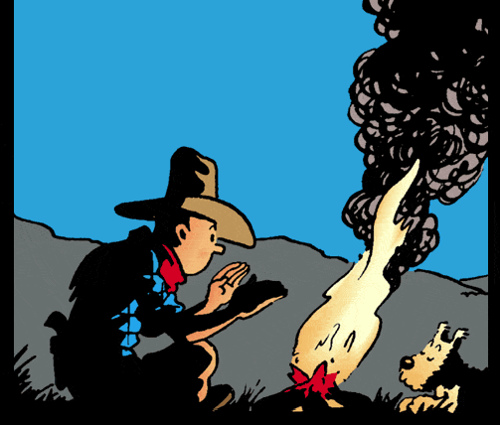
And
I
guess that these Belgian comic books about a reporter and his dog
having thrilling adventures at the four corners of the world, drawn
with great accuracy by Hergé
in a style called “la ligne claire”
(the clear line) have unconsciously taught me how to construct a story
and what are the elements that keep it together and “entertaining”:
beginning, rhythm,
progression, climax, plot, suspense, end, characters. It also taught me
to try and make pictures with great depth of field.
People
like
Gene
Smith,
Gene
Richards, Gilles Peress,
Larry Towell
and so many other photographers have, in fact, only translated in
photography what I more or less already learned through Tintin about constructing a story.
But
when
I
was
a
kid my parents also showed me paintings by Pieter Brueghel (here: “The Triumph of
Death”)
Jeroen Bosch (Here: “Hell” from the
tryptich “Garden of
delights”)
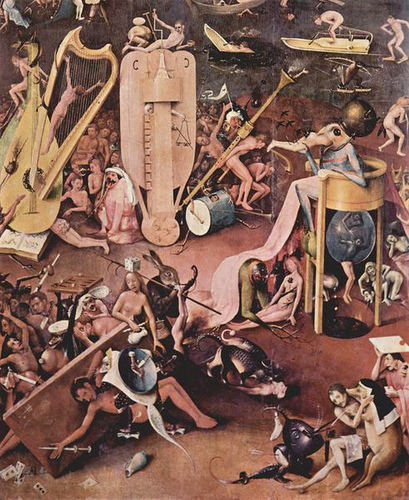
Jan
Van Eyck (Here: “Virgin with
the chandelier”)
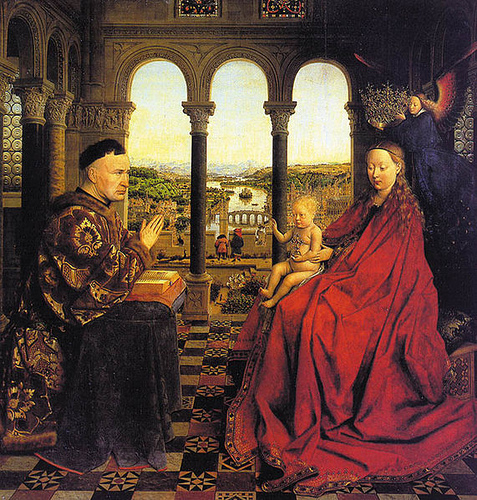
…and
other
Flemish
painters…
Imagine
what stories you can make up in your
mind as a small kid when you see people being skinned alive in hell?
Later
there
was
Wassily Kandinsky:
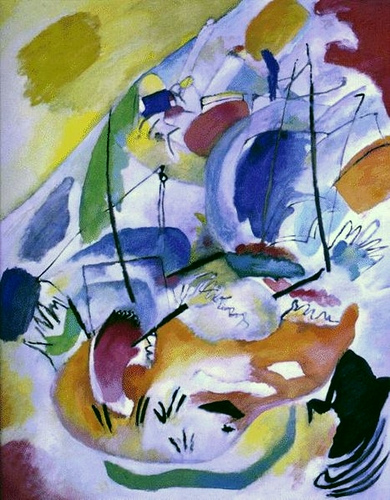
Or
Joan Mirò (Woman
Dreaming of Escape. 1945)
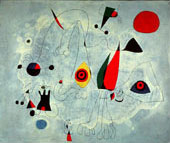
That
is
the
power
of
painting: so many stories, so much information,
in
one and only frame.
Photography
usually
needs
more
than
one frame, at least with the kind of
photography I am doing. That is perhaps the limitation / asset of my
photography. It seems that the more I go ahead, the more I have to have
pictures relying on another one, that one picture on its own loses some
of its power if it is not part of a thread. That the thread is what my pictures are about. And
it somehow makes sense as I have been favouring
the story as opposed to anything else for so many years.
To
build that thread is a matter of collecting bits and pieces, left and
right, without apparent immediate connection. It’s like a craftsman
making the pieces of a puzzle he has the concept about but not the
final image. The tricky part is not to forget to collect one piece or
another, as a seemingly unimportant situation may in fact be crucial to
the understanding of other parts of the story. For example during my
first trip to Cambodia in 1989 I completely overlooked the fact that I
had to take pictures of the empty streets of Phnom Penh, of the
twilight just before curfew, of the absence of circulation. In
retrospect it is the most obvious change with today and those pictures
I did not take could have come in handy at one point.
But
you also have to keep an open mind and at the same time be strict and
coherent regarding the concept. You have to adapt the concept in the
light of what you encounter but at the same time keep an eye on the
initial idea. It is only at the very end, when the story is finished
(but is it ever finished?), when you look at the outcome that you start
piecing things together and try to convey and reconcile both what your
initial idea was and what changes you found with the initial idea
during the quest for bits and pieces. I mean: you learn a lot about
things during the collection process, you refined the initial idea and
therefore you have to integrate that in the final result.
With
me the initial idea grows usually out of some other story. It doesn’t
come out of the blue. It’s more of a maze. That’s how I very often end
up working on several stories simultaneously, because suddenly an
interesting situation leads me to initiate a new thread. The decision
to pursue one thread or another and how I do it is probably as far as I
will go in revealing my feelings about a situation. I never use the “I”
word in my stories. The “I” word would only be a distraction.
The
multimedia thing is just a logical extension of the storytelling and is
realistically possible only since a few years thanks to the Internet
and broadband (which I don’t have by the way). It is adding a range of information to the photographs. If
done properly it helps in apprehending.
Wayne:
You use the term “paroxysm” to talk about what draws you to a story.
What do you mean by the word, especially in light of your coverage of
the dislocations to people, especially those relating to the most
elemental (famine and drought, land grabbing), and how powerless and
poor are most affected by those dislocations? Can you also talk about
the concept with regards to your story on Terre Rouge relocation?
John:
I used paroxysm in the sense of crisis, when things go out of hand,
when common rules don’t apply anymore. When things are being
deconstructed, torn apart and when journalists pop up from all over. I
usually come after the paroxysm, the crisis, when things are in
suspension or settle down, when things are being rebuilt, reconstructed.
True
that
the particular case of relocations of people in Cambodia are to be
considered a crisis, but compared to what happened before that in the
country, one can also see it as a (painfull)
part
of
the
reconstruction
of Cambodia as a “normal” country. I
wouldn’t want to sound cynical, but the basic idea I have behind
everything I am doing here in Cambodia is documenting the
reconstruction of the country after the Khmer Rouge regime. What does
it take to recover from near-total destruction, be it infrastructural,
moral, social? Every single
story I am doing on Cambodia can be seen from that perspective. The Terre Rouge relocation
is just one chapter in the Quest for Land, a story about land issues in
Cambodia I am working on, and that in turn is just part of another
story about the reconstruction of Cambodia, just like the several other
stories I am doing evolving around the Khmer Rouge tribunal. Imagine
documenting a country being rebuilt from scratch.
That
is
why
I
stay
here. And that is why I will stay for quite some more
time…
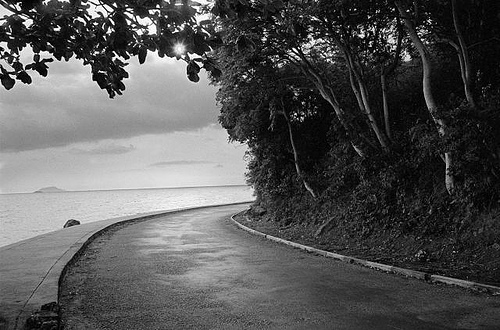
CAMBODIA. Kep
(Kampot). 13/04/2003
  
|
